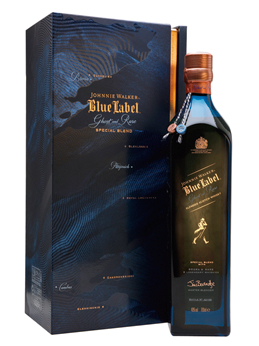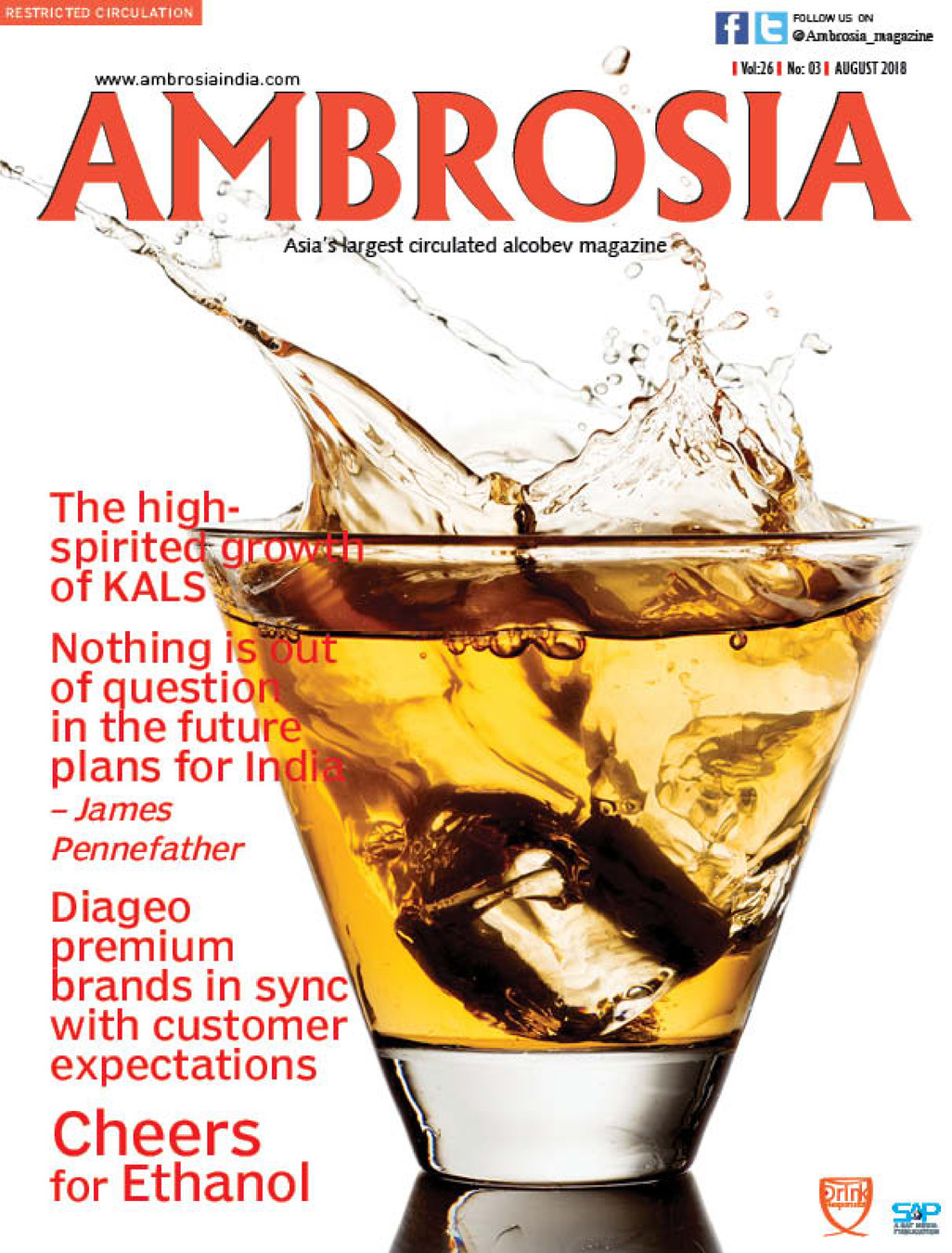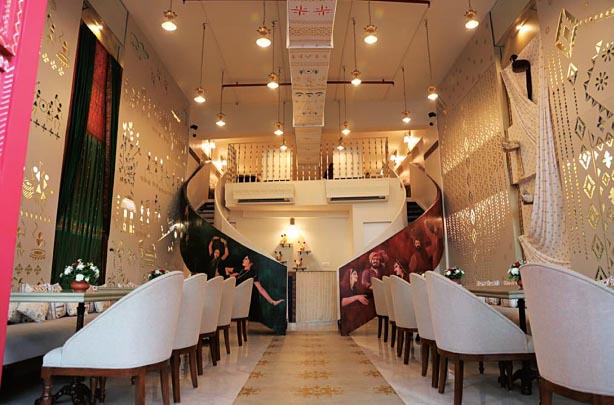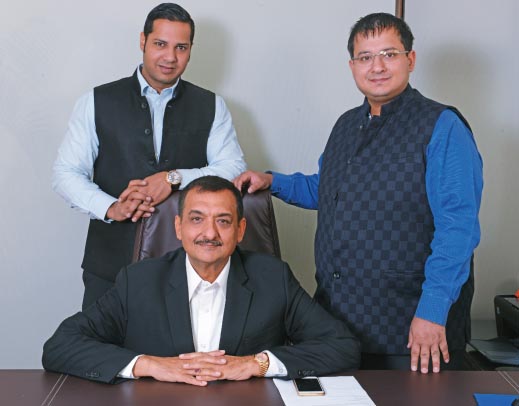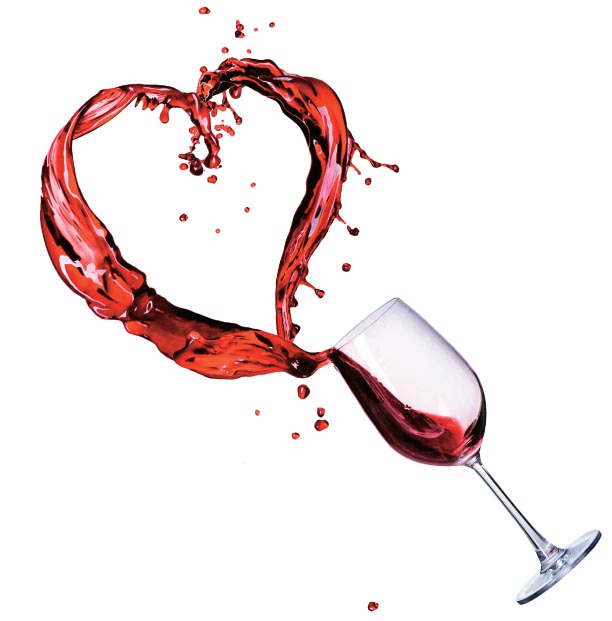
Large observational studies have found beneficial cardiovascular effects with moderate alcohol consumption.
The effect of alcohol consumption on the cardiovascular system has been the source of much debate over the past few years. Heavy alcohol consumption is associated with detrimental effects on many of the body’s systems, as well as with an increased risk of addiction, motor vehicle accidents, trauma, violence, cancer, and suicide. However, large epidemiological studies also point to a multitude of potential beneficial effects with chronic moderate alcohol consumption – defined here as up to two standard alcoholic drinks (44 mL spirits, 148 mL wine, or 355 mL beer) per day for men and up to one drink per day for women. Observational studies have compared subjects abstaining from alcohol with subjects consuming alcohol and found differences in all-cause mortality and mortality due to cancer, stroke, and coronary artery disease. Despite some adverse effects on arrhythmogenesis and blood pressure, alcohol has been found to generally benefit vascular health and to lower the risk of coronary artery disease. Evidence regarding the effects of alcohol on the cardiovascular system indicates that moderate consumption of up to two drinks per day for men and one drink per day for women is associated with the greatest potential benefit at the lowest overall risk. However, randomised controlled trials are still needed to determine whether the observed associations result from alcohol consumption alone and whether the benefit found relates to the kind of alcoholic beverage consumed.
Heavy alcohol consumption is associated with detrimental effects on many of the body’s systems, as well as with an increased risk of addiction, motor vehicle accidents, trauma, violence, cancer, and suicide. However, large epidemiological studies also point to a multitude of beneficial effects with chronic moderate alcohol consumption. Evidence regarding the effect of surrounding moderate alcohol consumption on the cardiovascular (CV) system is well worth considering.
Definitions
Many different definitions are used in the literature for a “standard” drink and “moderate” alcohol consumption. In this article we use the Department of Health and Human Services and the US Department of Agriculture definition for a standard drink, which is 17.74 mL or 14 g of alcohol. This represents 44 mL (1.5 fl. oz.) of 80-proof spirits, 148 mL (5 fl. oz.) of wine, or 355 mL (12 fl. oz.) of beer. Moderate alcohol consumption is defined in the same guideline as up to two alcoholic drinks per day for men and up to one alcoholic drink per day for women.
Alcohol and mortality
The relationship between alcohol consumption and all-cause mortality has been found to conform to a J-shaped curve, which is attributed to a combination of the beneficial and harmful effects of chronic alcohol consumption. This was clearly demonstrated in a large meta-analysis involving the study of over 1 million subjects.[1] The greatest benefit on all-cause mortality was observed in subjects consuming 6 g of alcohol per day (approximately half a drink per day), while parity with abstainers was reached with subjects consuming around 44 g per day (approximately three drinks per day). Thereafter, higher levels of alcohol consumption were associated with an increase in all-cause mortality.
While both sexes benefitted from chronic alcohol consumption, the authors noted a gender difference with respect to degree of benefit and level of consumption. Although the observed maximum protection of alcohol was similar between the sexes (18% in women and 17% in men) the slopes of the two curves differed, as seen in Figure 1. Whereas up to three drinks per day remained protective in men, women only derived benefit if they consumed less than two drinks per day.
Multiple studies have attempted to subquantify the effect of alcohol consumption on the various modalities of death with remarkably similar results. When taken together, the risk of dying a cardiovascular death appears to conform to an inverse or L-shaped mortality curve, with apparent risk reductions even with consumption of more than two drinks per day.[2,3] The beneficial effects of increasing alcohol consumption on cardiovascular mortality seem to apply to most subtypes of cardiovascular disease, and are generalisable to the elderly and those with a lower baseline risk or type 2 diabetes.[2-4]
Unfortunately, the cardiovascular benefit of increasing alcohol consumption is offset by an increase in noncardiovascular death.[2,3] Specifically, there is a significant association between increasing alcohol consumption and risk of death from cirrhosis, trauma, and cancer (Figure 2).[2,3] Not surprisingly, alcohol-related cancers (mouth, esophagus, pharynx, larynx, and liver) increase in frequency with increasing consumption (RR 1.5 for two to three drinks per day [confidence interval (CI) 1.1–2.1 for men and 0.9–2.5 for women]; RR 2.8 [CI 2.1–3.8] in men and 3.0 [CI 1.7–5.3] for women for more than four drinks per day). Somewhat unexpectedly, there was an observed increase in breast cancer mortality for women who consumed even one drink per day (RR 1.3 [CI 1.1–2.6]). There was no observed relationship between colon cancer risk and alcohol consumption.[2]
When compared with either heavy consumption or abstinence, moderate alcohol consumption is associated with a lower risk of all-cause mortality. With increasing consumption, the risk of cardiac mortality continues to decrease, but the risk of noncardiac mortality (hemorrhagic stroke, cancer, cirrhosis, trauma) increases. The benefit of moderate alcohol consumption applies to the middle-aged and the elderly, as well as to those with diabetes. A gender difference exists, with women deriving less benefit than men at increasing levels of alcohol consumption.
Alcohol and arrhythmia
The association between alcohol consumption and arrhythmia has long been described, with acute episodes of “holiday heart” (acute rhythm disturbance) occurring in association with episodes of binge drinking. But what of the risk of atrial fibrillation with chronic alcohol consumption? The literature on this topic suggests that the higher risk is confined to heavy drinking, although the threshold of risk differs between studies.[5,6] After adjusting for confounders, the Framingham study demonstrated a 34% increase in the risk of developing atrial fibrillation or flutter with consumption of more than 2.5 alcoholic drinks per day, while data from the Copenhagen City Heart Study suggest the risk of atrial fibrillation only increases with consumption above five drinks per day (hazard ratio 1.45 [CI 1.02–2.04]).5, Neither of these studies demonstrated a significant association between alcohol consumption and atrial fibrillation in women, although the reason for this remains unclear.
In terms of ventricular arrhythmias, there is a known association between heavy alcohol consumption and sudden cardiac death.[7] However, as with all-cause mortality, the risk of sudden cardiac death appears to decrease with moderate alcohol consumption.[8] After adjusting for confounders of sudden cardiac death, there was an observed U-shaped curve describing the relationship between alcohol consumption and sudden cardiac death, with significantly reduced risk in men who consumed two to four drinks per week (RR 0.4 [CI 0.22–0.75]) and five to six drinks per week (RR 0.21 [CI 0.08–0.56]) compared with men who rarely or never consumed alcohol. With two or more drinks per day the relationship approached unity.
Alcohol is proposed to increase arrhythmogenesis by way of the hyperadrenergic state of drinking and withdrawal, as well as by way of associated proarrhythmic electrolyte abnormalities such as hypomagnesemia. Likewise, alcohol is known to impair vagal heart rate control, and prolong the QT interval. Most of these effects are observed at high levels of consumption. Therefore, at lower levels of consumption the arrhythmogenic effect of alcohol is minimal and is largely outweighed by the other beneficial effects that alcohol can have on overall vascular health.
Alcohol and CV risk factors
The proposed benefits of chronic moderate alcohol consumption are thought to derive from the effects of alcohol on overall vascular health. Specifically, studies have shown that regular moderate alcohol consumption is associated with improved endothelial function, reductions in inflammation, plasma viscosity and platelet aggregation, as well as induction of a favourable lipid profile.9-12 Some of these effects are almost instant (such as the increase in serum HDL-C within 1 hour of alcohol consumption), whereas others appear to be long lasting even without regular consumption (such as the lowered plasma viscosity even after 3 weeks of abstinence).[13,14]
But not all cardiovascular risk factors are affected equally. Specifically, the adverse role of alcohol on blood pressure is well described. The Canadian Hypertension Society estimates that 4.0% to 9.2% of Canadian men and 0.6% to 2.6% of Canadian women have hypertension attributable to alcohol consumption.[15] In the large INTERSALT trial, consumption of three to five drinks per day was associated with a 2.7/1.6 mm Hg rise in blood pressure in men and 3.9/3.1 mm Hg in women. For men, blood pressure increased by 4.6/3.0 mm Hg for five or more drinks per day.[16] Whereas moderate alcohol consumption was not associated with an increased risk of high blood pressure in the INTERSALT trial, a recent Mendelian randomised trial showed an estimated 0.24 mm Hg rise in systolic blood pressure per gram of alcohol consumed daily (3.36 mm Hg per drink per day).17 That being said, a study of 14 125 known hypertensive men showed that the risk of all-cause mortality and cardiovascular mortality decreased with moderate alcohol consumption when subjects were compared with abstainers (multivariate RR 0.56).[18]
Alcohol and CAD
The role of moderate alcohol consumption has also been examined with respect to the risk for developing coronary artery disease (CAD). In a prospective study of over 20 000 apparently healthy men, moderate alcohol consumption had a strong, independent, inverse association with the risk of developing angina pectoris (RR 0.69 [CI 0.59–0.81]) or sustaining a myocardial infarction (RR 0.65 [CI 0.52–0.81]).[19] This observation appears to be independent of baseline CV risk with similar trends observed in the healthiest subset of the Health Professionals Follow-Up Study.[20]
Even when CAD is established, moderate alcohol consumption continues to be associated with improved outcomes. In a study of over 2100 subjects consecutively undergoing coronary angiography, moderate alcohol consumption was the only negative predictor of cardiac mortality over a median follow-up of 93 months (hazard ratio 0.84 [CI 0.71–1.0]).[21] Likewise, in patients followed after coronary artery bypass grafting, moderate alcohol consumption was associated with a nonsignificant trend toward less angiographic progression (odds ratio 0.7 [CI 0.4–1.1]) and fewer clinical events—death, MI, stroke, bypass surgery, or angioplasty (hazard ratio 0.7 [CI 0.5–1.1]).[22]
In patients with acute coronary syndrome, chronic alcohol consumption appears to play a favourable role, perhaps secondary to the aforementioned beneficial platelet aggregation and blood viscosity effects. After adjusting for propensity to drink and other confounders, increasing alcohol consumption over the year prior to MI remained predictive of lower total and cardiovascular mortality (adjusted hazard ratio 0.79 for less than one drink per day [CI 0.6–1.3], and adjusted hazard ratio 0.68 for one drink or more per day. [CI 0.45–1.05]).[23]
Alcohol and heart failure
It is well known that heavy alcohol consumption is associated with significant abnormalities in both systolic and diastolic function.[24] This same observation does not necessarily hold true for moderate levels of alcohol consumption, based on multiple large observational trials where subjects who consumed moderate levels of alcohol were compared with abstainers and found to have a lower incidence of symptomatic heart failure (adjusted RR 0.41–0.66 for one drink per day).[25,26] In patients with established heart failure the benefits of ongoing moderate alcohol consumption are dependent on the underlying cause of cardiomyopathy. A recent analysis of the SOLVD (Studies of Left-Ventricular Dysfunction) cohort examined patients with predominantly NYHA functional class I and II ischemic and nonischemic cardiomyopathy with a left ventricular ejection fraction of less than 35%. The authors demonstrated that moderate alcohol consumption significantly decreased all-cause, noncardiovascular, and MI-related mortality in the ischemic but not idiopathic dilated cardiomyopathy population over an average of 3 years of follow-up.[27]
Up to this point we have not discussed the role of chronic alcohol consumption in alcoholic cardiomyopathy, a specific form of dilated cardiomyopathy related to longstanding heavy alcohol use (5 to 20 years of more than six drinks per day). Conventional wisdom has been that alcoholics with alcohol-induced cardiomyopathy must abstain from alcohol. This assertion was supported by a study showing improved ejection fraction and 7-year transplant-free survival in those who completely abstained (45%) versus those who continued to abuse alcohol (27%).[28] However, a separate study of alcohol abusers (more than seven drinks per day for more than 10 years) with established alcohol-induced cardiomyopathy demonstrated comparable persistent improvements in ejection fraction when those who were able to moderate their drinking (less than four drinks per day) were compared with abstinent subjects. The improvement in ejection fraction was blunted in those consuming four to six drinks per day, and continued consumption more than six drinks per day resulted in progressive ejection fraction deterioration.[29]
Caveats
Detractors may question the ability of studies using self-reported data to accurately estimate consumption and adequately control for confounders such as social status and access to health care. While only observational in nature, these studies did attempt to address these concerns. First, it is known that self-reported alcohol consumption is generally reliable, particularly regarding mild to moderate levels of consumption. Although heavy drinkers have a tendency to underreport their consumption, inadvertently including their data with the mild-to-moderate group would only serve to cause an underestimation of the beneficial effects of moderate levels of consumption. Second, we know that levels of moderate alcohol consumption tend to remain reasonably stable over time, with 95% of nondrinkers continuing to abstain or drink less than two drinks per week 10 years after enrollment.[2] Likewise, 78% of the current drinkers remained in the same or adjacent (usually lower) category of consumption. Lastly, nearly all of the included observational studies made adjustments for common confounders, and the adjusted relative risks and odds ratios are those that are reported here. Another criticism of the mostly large-scale, cross-cultural observational studies described here cannot be addressed so easily. Unfortunately, these types of studies are based on the false assumption that culturally or genetically diverse populations have similar susceptibilities to environmental factors. Despite a pressing need for randomised control trials, these have yet to be performed, so it is unclear whether the observed associations result from factors other than alcohol consumption.
Yet another concern about most of the evidence presented here relates to the fact that only ongoing, chronic consumption is considered. This means we have limited knowledge regarding the potential benefits of initiating moderate alcohol consumption in abstainers. A recent study from 2008 showed that after four years of follow-up, new light-to-moderate drinkers (up to two drinks per day in men, up to one drink per day in women) had a 38% reduction in their chance of developing CV disease when compared with persistent abstainers. This difference remained after adjustment for demographic and CV risk factors (odds ratio 0.62 [CI 0.4–0.95]). However, over this limited follow-up period there was no difference in mortality between the new drinkers and persistent abstainers.[30]
Last, the question has been raised regarding whether it matters what you drink. While the results of some mainly European studies suggest that the benefit lies exclusively in consumption of wine, a large American study of nearly 40 000 subjects did not find any difference in type of beverage consumed and myocardial infarction risk after 12 years of follow-up.[31] Further studies are needed to clarify this issue.
Conclusions
Observational studies completed to date indicate that the potential benefits of alcohol consumption depend on the level of intake as well as the specific body system and outcome being examined. While cardiovascular benefit may be observed with increasing consumption, heavy consumption is associated with detrimental noncardiovascular outcomes. As such, based on the current state of evidence, for the average individual, consumption of up to two drinks per day for men and one drink per day for women is associated with the greatest potential cardiovascular benefit at the lowest overall risk. Randomised controlled trials are still needed, however, to determine whether the observed associations result from alcohol consumption alone and whether the benefit found relates to the kind of alcoholic beverage consumed.
Competing interests
None declared.
References
1. Di Castelnuovo A, Costanzo S, Bagnardi V, et al. Alcohol dosing and total mortality in men and women: An updated meta-analysis of 34 prospective studies. Arch Intern Med 2006;166:2437-2445. Full Text
2. Thun MJ, Peto R, Lopez AD, et al. Alcohol consumption and mortality among middle-aged and elderly U.S. adults. N Engl J Med 1997;357:1705-1714. Full Text
3. Goldberg RJ, Burchfiel CM, Reed DM, et al. A prospective study of the health effects of alcohol consumption in middle-aged and elderly men. The Honolulu Heart Program. Circulation 1994;89:651-659. Full Text
4. Valmadrid CT, Klein R, Moss SE, et al. Alcohol intake and the risk of coronary heart disease mortality in persons with older-onset diabetes mellitus. JAMA 1999;282:239-246. Full Text
5. Djoussé L, Levy D, Benjamin EJ, et al. Long-term alcohol consumption and the risk of atrial fibrillation in the Framingham Study. Am J Cardiol 2004;93:710-713. PubMed Abstract
6. Mukamal KJ, Tolstrup JS, Friberg J, et al. Alcohol consumption and risk of atrial fibrillation in men and women: The Copenhagen City Heart Study. Circulation 2005;112:1736-1742. Full Text
7. Wannamethee G, Shaper AG. Alcohol and sudden cardiac death. Br Heart J 1992;68:443-448. Full Text
8. Albert CM, Manson JE, Cook NR, et al. Moderate alcohol consumption and the risk of sudden cardiac death among US male physicians. Circulation 1999;100:944-950. Full Text
9. Teragawa H, Fukuda Y, Matsuda K, et al. Effect of alcohol consumption on endothelial function in men with coronary artery disease. Atherosclerosis 2002;165:145-152. PubMed Abstract
10. Imhof A, Woodward M, Doering A, et al. Overall alcohol intake, beer, wine, and systemic markers of in?ammation in western Europe: Results from three MONICA samples (Augsburg, Glasgow, Lille). Eur Heart J 2004;25:2092-2100. Full Text
11. de Lorgeril M, Salen P. Wine ethanol, platelets, and Mediterranean diet. Lancet 1999;353:1067. PubMed Abstract
12. Suh I, Shaten BJ, Cutler JA, et al. Alcohol use and mortality from coronary heart disease: The role of high-density lipoprotein cholesterol. Ann Intern Med 1992;116:881-887. Full Text
13. Veenstra J, Ockhuizen T, van de Pol H, et al. Effects of a moderate dose of alcohol on blood lipids and lipoproteins postprandially and in the fasting state. Alcohol Alcohol 1990;25:371-377. Abstract
14. Jensen T, Retterstøl LJ, Sandset PM, et al. A daily glass of red wine induces a prolonged reduction in plasma viscosity: A randomized controlled trial. Blood Coagul Fibrinolysis 2006;17:471-476. PubMed Abstract
15. Campbell NR, Ashley MJ, Carruthers SG, et al. Lifestyle modifications to prevent and control hypertension. 3. Recommendations on alcohol consumption. Canadian Hypertension Society, Canadian Coalition for High Blood Pressure Prevention and Control, Laboratory Centre for Disease Control at Health Canada, Heart and Stroke Foundation of Canada. CMAJ 1999;160(9 suppl):S13-S20. Full Text
16. Marmot MG, Elliott P, Shipley MJ, et al. Alcohol and blood pressure: The INTERSALT study. BMJ 1994;308:1263-1267. Full Text
17. Chen L, Davey Smith G, Harbord RM, et al. Alcohol intake and blood pressure: A systematic review implementing a mendelian randomization approach. PLoS Med 2008;5:e52. Full Text
18. Malinski MK, Sesso HD, Lopez-Jimenez F, et al. Alcohol consumption and cardiovascular disease mortality in hypertensive men. Arch Intern Med 2004;164:623-628. Full Text
19. Camargo Jr CA, Stampfer MJ, Glynn RJ, et al. Moderate alcohol consumption and risk for angina pectoris or myocardial infarction in U.S. male physicians. Ann Intern Med 1997;126:372-375. PubMed Abstract
20. Mukamal KJ, Chiuve SE, Rimm EB. Alcohol consumption and risk for coronary heart disease in men with healthy lifestyles. Arch Intern Med 2006;166:2145-2150. Full Text
21. Femia R, Natali A, L’Abbate A, et al. Coronary atherosclerosis and alcohol consumption: Angiographic and mortality data. Arterioscler Thromb Vasc Biol 2006;26:1607. Full Text
22. Mukamal KJ, Girotra S, Mittleman MA. Alcohol consumption, atherosclerotic progression, and prognosis among patients with coronary artery bypass grafts. Am Heart J 2006;151:368-372. PubMed Abstract
23. Mukamal KJ, Maclure M, Muller JE, et al. Prior alcohol consumption and mortality following acute myocardial infarction. JAMA 2001;285:1965-1970. Full Text
24. Lazarevic AM, Nakatani S, Neskovic AN, et al. Early changes in left ventricular function in chronic asymptomatic alcoholics: Relation to the duration of heavy drinking. J Am Coll Cardiol 2000;35:1599-1606. PubMed Abstract
25. Walsh CR, Larson MG, Evans JC, et al. Alcohol consumption and risk for congestive heart failure in the Framingham Heart Study. Ann Intern Med 2002;136:181-191. PubMed Abstract
26. Djoussé L, Gaziano JM. Alcohol consumption and risk of heart failure in the Physicians’ Heath Study I. Circulation 2007;115:34-39. Full Text
27. Cooper HA, Exner DV, Domanski MJ. Light-to-moderate alcohol consumption and prognosis in patients with left ventricular systolic dysfunction. J Am Coll Cardiol 2000;35:1753-1759. PubMed Abstract
28. Gavazzi A, De Maria R, Parolini M, et al. Alcohol abuse and dilated cardiomyopathy in men. Am J Cardiol 2000;85:1114-1118. PubMed Abstract
29. Nicolas JM, Fernandez-Sola J, Estruch R, et al. The effect of controlled drinking in alcoholic cardiomyopathy. Ann Intern Med 2002;136:192-200. PubMed Abstract
30. King DE, Mainous AG 3rd, Geesey ME. Adopting moderate alcohol consumption in middle age: Subsequent cardiovascular events. Am J Med 2008;121:201-206. Full Text
31. Mukamal KJ, Conigrave KM, Mittleman MA, et al. Roles of drinking pattern and type of alcohol consumed in coronary heart disease in men. N Eng J Med 2003;348:109-118.
Dr Andrade is a cardiology fellow at the University of British Columbia. Dr Gin is a clinical professor in the Department of Medicine at the University of British Columbia and director of the UBC postgraduate cardiology programme. He is also associate director of the Vancouver General Hospital cardiac care unit and echocardiography laboratory.
